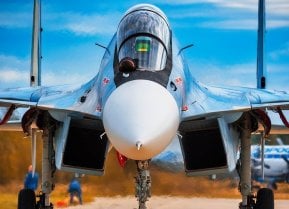Why Iran Flies the F-14 Tomcat Fighter Like in Top Gun
No matter how much Tehran has maintained and improved its originally imported fleet of F-14 Tomcats, this platform simply does not hold up to more advanced next-generation counterparts.
The star fighter jet in the blockbuster hit Top Gun may appear like a vintage relic for viewers today. Introduced more than five decades ago, the American-made F-14 Tomcat was a formidable force to be reckoned with back in the day.
While the F/A-18 Hornet supplanted the aging airframe, one nation still flies the Tomcat as its premiere fighter platform. The Islamic Republic of Iran maintains a fleet of F-14s, which it has modified over the years to remain relevant in the modern age of aviation.
If America could go back in time, it probably would not have granted Tehran the ability to fly the F-14 Tomcat.
A brief history of the F-14 Tomcat
Following the Second World War, the U.S. military desired a long-range and high-endurance interceptor to better protect carrier strike groups out at sea.
As the threat landscape was shifting amidst the rise of the Cold War, the Navy specifically required airframes that could go up against the Soviet’s counterparts. Over the next few years, the F-4 Phantom II and the Douglas F6D Missileer would be introduced.
However, neither would fit the bill for the Navy. Around this time, then-Secretary of Defense Robert McNamara established the Tactical Fighter Experimental (TFX) program, designed to create a joint airframe for both the Navy and Air Force.
Ultimately, Northrop Grumman and McDonnell Douglas were selected as finalists and Grumman was awarded the contract by 1969.
Grumman’s initial design plans incorporated the TF30 engines used to power the F-111B airframe. However, the service did always intend to replace these engines with the newer Pratt & Whitney F401-400 engines.
The jet’s distinctive swept wings enable it to cruise at a speed of Mach-2.4 (times the speed of sound) while also maintaining control at the slow speeds required for carrier recovery.
Armament-wise, the F-14 can pack a punch. Armed with a General Electric Vulcan M61A-1 20mm gun with 675 rounds of ammunition, there is a reason the Tomcat was considered the ultimate dog-fighter for so many years.

The fighter also features eight hardpoints for carrying ordnance, including short, medium, and long-range air-to-air missiles AIM-9, Aim-54, and AIM-7. Additionally, the jet can carry air-to-ground ordnance like the CBU cluster bombs and Rockeye bombs.
How did Iran come into the picture?
The F-14’s formidable features were observed across the globe when the platform took to the skies in the 1970’s. As tensions between the U.S. and USSR were ramping up at this time, the then-Nixon administration was seeking allies from the region
. The president even visited the Iranian head of state, Mohamed Reza Shah, to set up an arrangement that would give Imperial Iran 79 operational Tomcat fighters.
Analysts consider the F-14 to have been the equivalent of what the F-22 is today - truly an unparalleled fighter. It made sense for Imperial Iran to procure the Tomcats since these jets would provide a robust counter to the Soviet’s MiG-25R Foxbat. Notably, this $2 billion deal would become the largest single foreign military sale in American history.
While the arrangement to deliver these F-14sto Iran seemed like a good idea at the time, the arrival of the 1979 Islamic Revolution would leave the White House regretful of this decision. Monarchical rule was abruptly obliterated in Iran when fundamentalist Shiite clerics took control over the country under the leadership of Ayatollah Ruhollah Khomeini. Following this transition of power, the newly established Islamic Republic functioned under the guide that the U.S. was “the Great Satan.”
In other words, America’s adversary now had in their possession dozens of its top fighter jets.
Iran still flies its F-14Tomcats:
Over the next few decades, Iran would use the Tomcat extensively in combat.
As detailed by Popular Mechanics, “Over the course of 34 years of service, from 1972 to 2006, American F-14 pilots shot down five enemy aircraft. During that same time, several Iranian pilots claimed that many kills individually. Working from interviews, news reports, and public records, authors Tom Cooper and Farzad Bishop estimated that during the eight years of the Iran-Iraq war, the Iranian F-14 pilots scored 159 total kills—and that was coming from a depleted regime, under heavy sanctions, flying no more than a few dozen planes provided by the Great Satan himself.”
Iran kept the platform relevant over the years through self-sufficiency programs and the black market.
To fulfill material needs for the platform, Tehran expanded its autonomy in agriculture, electricity generation, steel production and civil aviation.
In the U.S., federal agents charged individuals in the late 1990s for the illicit trade of spare Tomcat engine parts.
No matter how much Tehran has maintained and improved its originally imported fleet of F-14 Tomcats, this platform simply does not hold up to more advanced next-generation counterparts.
Maya Carlin is an analyst with the Center for Security Policy and a former Anna Sobol Levy Fellow at IDC Herzliya in Israel. She has by-lines in many publications, including The National Interest, Jerusalem Post, and Times of Israel. You can follow her on Twitter: @MayaCarlin.
All images are Creative Commons.


